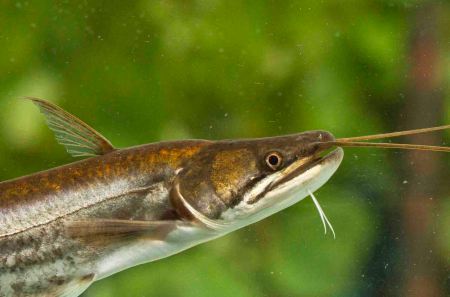In this season of giving, scientists studying biodiversity at the University of Peradeniya have offered Sri Lanka a gift that generations will want to remember – two new species of catfish endemic to the island.
One specimen is scientifically named as Mystus nanus with its latin name ‘nanus’ meaning ‘dwarf’ as the fish is comparatively small, growing between 8 centimeters and 10 cm. The other, is named as Ompok argestes, where ‘argestes’ refers to its range meaning ‘southwest’ indicating its presence in the southern wet zone.
Both these catfish were earlier thought to be native to Sri Lanka and India, but based on scientific findings, researcher Hiranya Sudasinghe determined they are separate species. The species in Sri Lanka only inhabits the island. Sudasinghe told the Sunday Times that he had visited South India to study the Indian catfish in same area where these species had been first detected.
Experts Rohan Pethiyagoda, Dr Kalana Maduwage, and Dr Madhava Meegaskumbura assisted the researchers. Studies also established the existence of another catfish species named Callichrous ceylonensis, earlier identified as a different species.
Catfish are a diverse group of ray-finned fish, with their fins being webs of skin supported by bony or horny spines. Catfish have two or four pairs of barbels and its resemblance to cat’s whiskers resulted in them being called that name. They inhabit the dark depths of rivers and muddy environments. They are also mostly nocturnal carnivores.
There are nearly 3,000 known species of catfish in the world and with the new discoveries, now there are nine different catfish species in Sri Lanka. The largest freshwater fish in Sri Lanka is also a catfish known in Sinhala as Walaya(shark catfish) which can grow up to a meter in length. “But now this large catfish is very rare, so its even categorised as endangered in the Red List of Sri Lanka published on 2012,” said Sudasinghe.

Hiranya Sudasinghe
The largest species of catfish is the Mekong catfish with the largest recorded measuring nearly three metres in length according to some reports.
Several exotic catfish species are popular aquarium fish with the most popular in Sri Lanka being the iridescent shark catfish, native to the rivers of Southeast Asia. It appears to glow because of its slimy skin.
Catfish are also known to be able to survive long out of the water. Some species move to a different water source, when their water hole dries up. They use their rigid pectoral fins as stilts to move. In Sri Lanka, both the walking catfish and stinging catfish are noted for being able to crawl on land.
Catfish do not have scales, but spines on dorsal and pectoral fins provide protection against predators. These spines can be locked into place so that they stick outwards. The hunga or stinging catfish as its name suggests, need to be handled with caution as it has venom glands linked to the fin spine that can deliver an extremely painful sting.
Another interesting fact about cat fish is that many can produce different types of sounds by rubbing their fins.
Habitat loss is a threat to this freshwater fish. Walaya and Ankutta are already tagged as endangered, and two other catfish as ‘near threatened’. Experts urge that freshwater habitat that remain be protected.

| The invasive ‘tank cleaner’ catfishKnown colloquially as ‘tank cleaners’ – the suckermouth catfish has now become an invasive species in a number of waterways in Sri Lanka. It native range is tropical South America, but it has become a popular aquarium fish due to its ability to clean algae from fish tanks. The fish are sold when they are small but with their feeding habits, they can quickly overgrow the tanks. Owners then release them to local waterways.
“Be responsible and never release your aquarium fish to any natural waterway,” appeals Subasinghe. This he, says can cause an imbalance in the ecology of the island’s freshwater habitats. List of catfish species found in Sri Lanka * Mystus nanus: endemic (the new discovery) – Sri Lankan Striped Dwarf Catfish (conservation status – LC) * Mystus ankutta: endemic – Sri Lanka Dwarf Catfish {Endangered – EN} * Mystus gulio: long-whiskered catfish; Anguluwa, {Least Concern – LC} * Mystus zeylanicus: endemic – Sri Lankan yellow catfish {Least Concern – LC} Family: siluridae * Ompok argestes – endemic (about 30 cm) (conservation status proposed as near threatened) * Ompok ceylonensis – endemic (about 30 cm) (conservation status proposed as least concern) * Wallago attu – shark catfish – Walaya in Sinhala (about 1 m – rare) {ENDANGERED – EN}: This is the largest freshwater fish in Sri Lanka Family: claridae * Clarias brachysoma – walking cat fish – (- Magura) endemic (about 50 cm ) {Near Threatened – NT} Family: heteropneustidae *Heteropneustes fossilis : Stinging catfish, (- Hunga) (about 30 cm) {Least Concern – LC} Invasive * Pterygoplichthys multiradiatus – suckermouth catfish * Clarias batrachus – marbled catfish: Most popular in the aquarium trade *Iridescent shark catfish – pangasianodon hypophthalmus Published on SundayTimes on 18.12.2016 http://www.sundaytimes.lk/161218/news/whiskered-native-handle-with-care-220972.html |
Tags: Catfish





Leave a comment